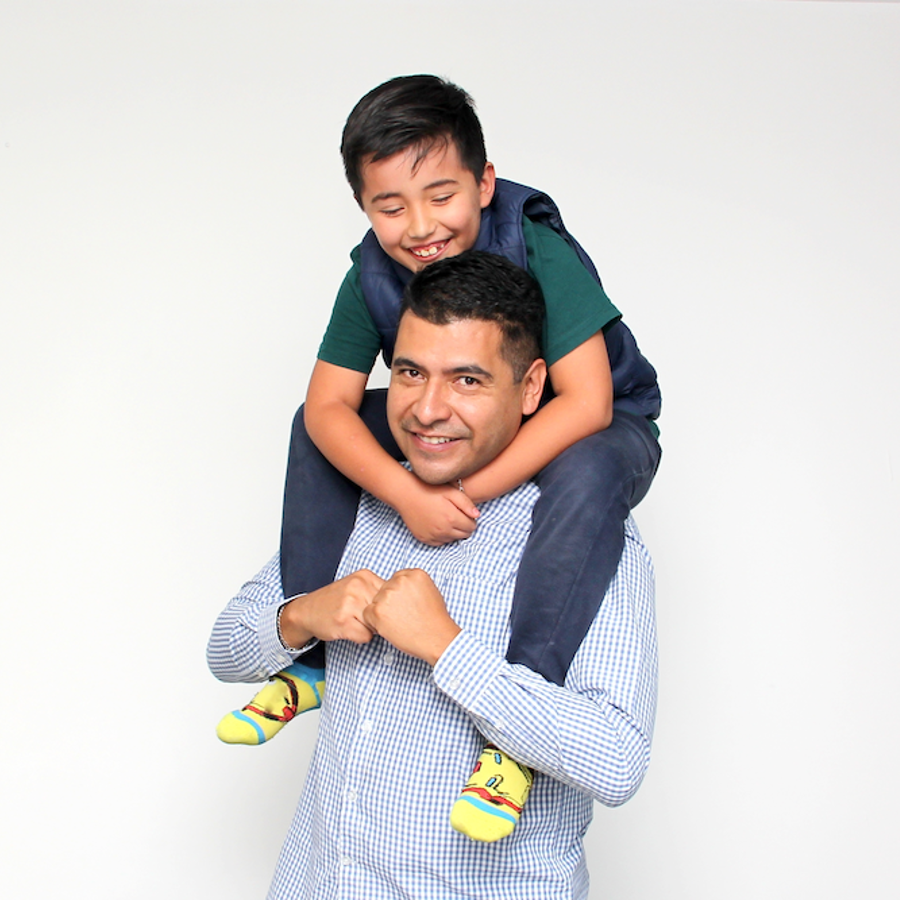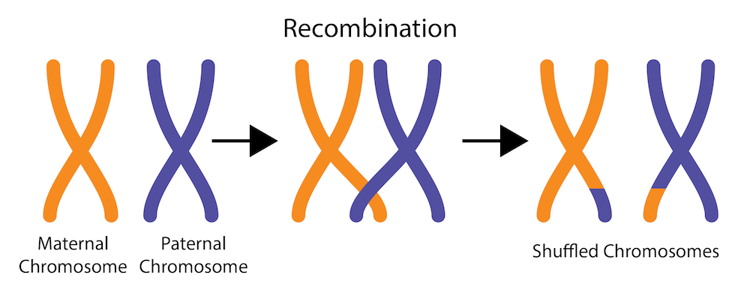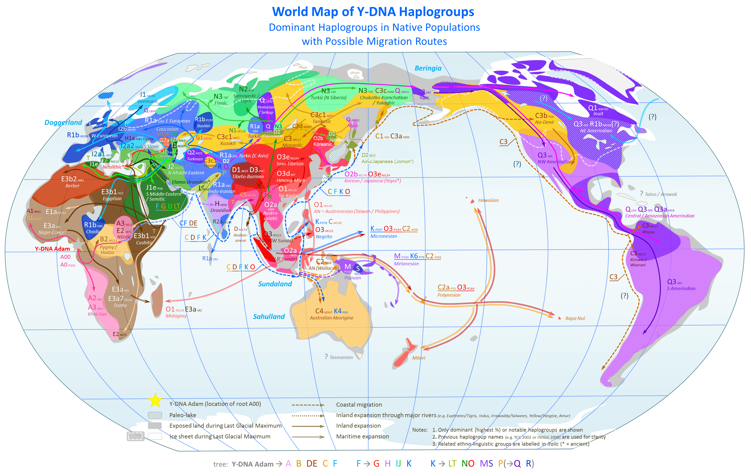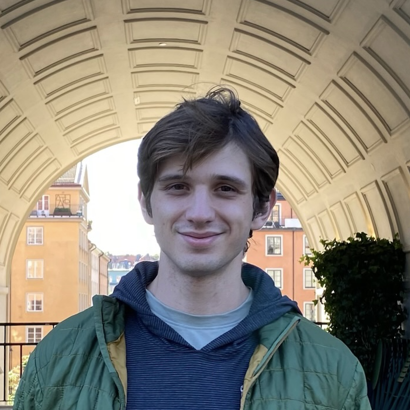
How does Y chromosome variation happen?
February 27, 2024

- Related Topics:
- Y chromosome,
- Evolution,
- Human evolution,
- Ancestry,
- Mutation
A curious adult from Louisiana asks:
How is variation of Y chromosomes explained? If your Y chromosome is identical to your father's, and grandfather's, all the way back for countless generations; then how far back does it go? All the way back to the first homo sapiens male? Homo habilis? Back to the first mammal? And if it copies identically, how is there more than one? And how many Y-lines (of ancestry) are there, even? There couldn't be many, if it copies identically, right?
The short answer — Y chromosomes are passed directly from father to son. However, we humans are not perfect at passing along chromosomes, so they change slightly from generation to generation. Keep reading to find out more!
How is our DNA packaged and inherited?
DNA is a long chain of information. If our cells didn’t have some way to organize it, it would be a tangled mess! Instead, we package our DNA into structures called chromosomes.
Most people have 46 chromosomes — 23 inherited from each parent. Two copies of Chromosome #1, two copies of Chromosome #2, and so on all the way through Chromosome #22.
But the 23rd pair of chromosomes is a little bit different. It comes in two versions: X and Y. These are called sex chromosomes, as they play a role in determining your biological sex. Most biological females have two X chromosomes, while most biological males have an X and a Y chromosome.
Most of the chromosomes trade bits with each other each generation. This recombination happens when sperm and egg are made. The two copies of chromosome 1 line up against each other and swap pieces. Then, one of those shuffled chromosomes gets passed onto the kid.

But this reshuffling requires a matched pair. For chromosomes 1-22 that’s no problem, they always match. But the sex chromosomes are often mismatched. When someone has two X chromosomes, they can line up and get reshuffled like the others. But if someone has an X and Y, they’re too different for this process to work.
That means that the Y chromosome doesn’t get reshuffled. It will be passed on unchanged from parent to child.
Are all Y chromosomes the same then?
Wouldn’t this suggest that the Y chromosome of a son is identical to his dad’s? And his dad’s dad? And all the way back for the very first Y chromosome?
Like most things in biology, it’s not that simple. Y chromosomes can change slightly with each generation.
When I mentioned that X and Y chromosomes can’t recombine, that’s 95% true. However, the very tips of X and Y chromosomes are similar enough to pair up and reshuffle a bit. This means that this small portion of the Y chromosome can contain DNA inherited from the paternal grandmother.
Okay, but if we ignore those regions, is the rest of the Y chromosome constant then?
Well, when we duplicate our DNA, errors are sometimes made. Can you imagine sitting down and copying a few billion letters without making a single mistake? Mistakes can and do happen!
Some kinds of mistakes are more likely than others. For example, it is particularly common to make a mistake in regions that are highly repetitive. Just imagine if you were supposed to copy down “ATAT” fifty times. It could be easy to lose track and skip a few, or add some extras.
Changes in these highly repetitive regions, called short tandem repeats (STR), are very common. With each generation, changes in STRs accumulate. This makes them a useful tool for comparing two samples of DNA, like in a paternity test or forensics.
Other kinds of mutations can also happen on the Y chromosome. When a single letter of DNA is changed for another letter, this is called a single nucleotide polymorphism (SNP). These happen much more rarely than STR mutations. Out of the 60 million bits of information in the Y chromosome, we might only get 1-2 mistakes per generation3.
How can the Y chromosome track ancestry?
Since SNPs happen slowly, they are useful for tracking our ancestry. Two people who have the exact same SNP on their Y chromosome probably got it from a shared ancestor. It is very unlikely that they developed the same mutation separately from each other.
We can look at Y chromosome SNPs around the world to piece together our shared ancestors and construct a global family tree. This tree is divided up into haplogroups, or groups of people sharing similar SNPs. There are currently roughly 20 major haplogroups in the world, each having many subgroups1.

If we extend the family tree all the way back in time, we can estimate the ancestor of all living haplogroups today. Researchers estimate that all human Y chromosomes stem from a single common ancestor in Africa some 200-300 thousand years ago2.
Is this the first human male? Definitely not! Just because all current Y chromosomes come from this person does not mean he was alone at the time. There were more humans alive then, but through one way or another, their Y chromosomes have been lost over time.
Researchers have also studied the Y chromosomes of some of our close relatives, Neanderthals and Denisovans. These ancient human groups split off from Homo sapiens long before our common Y chromosome ancestor lived. We would expect their Y chromosomes to look very different from our own.
When scientists looked at Denisovan Y chromosomes, they found this was true. The Y chromosome in Denisovans looks different from those found in humans today. It’s still clearly related to our Y chromosomes, but it isn’t the same.
However, Neanderthals’ Y chromosomes looked suspiciously similar to our own. But Neanderthals didn’t descend from our common Y chromosome ancestor, so how can this be?
Scientists now believe that Neanderthals originally had different Y chromosomes. However, long after the Neanderthals split off from us, they re-encountered humans and interbred. That introduced our own Y chromosomes into their population, which eventually replaced the original Neanderthal Y chromosome 4.
The bottom line is that DNA can be lost or replaced over time. We fully don’t know what other Y chromosomes existed ~250,000 years ago when our Y chromosome common ancestor lived. All we know is what has survived until today.
It’s also important to remember that the Y chromosome isn’t the only way to look at ancestry, human history, and relatedness. Chromosomes 1-22 are passed down from parents regardless of sex, so they’re a good way to learn more about both sides of your family. And your maternal line can be tracked with something called mitochondrial DNA, which is transferred directly from mother to child.
Tracing one’s ancestry is tricky, and it’s important to know its limitations. Nevertheless, the Y chromosome’s stability from generation to generation allows us to trace a paternal family line and glimpse into our past.

Author: Raleigh Slyman
When this answer was published in 2024, Raleigh was a Ph.D. candidate in the Department of Mechanical Engineering, studying human embryo organization in Ovijit Chaudhuri’s laboratory. He wrote this answer while participating in the Stanford at The Tech program.
 Skip Navigation
Skip Navigation
